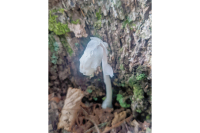Traffic footprint of Super Wal-Mart could reach far and wide
Brace yourself, West Waynesville: a new Super Wal-Mart and Home Depot complex due to open next summer will bring an extra 21,000 vehicles on to the surrounding roads on a typical Saturday, according to a recent traffic study conducted for the site.
Extra lanes and stop lights are in the works, but it’s unclear whether it will be enough to handle the full brunt of the traffic on South Main Street where measures to accommodate the extra cars are more limited. While the traffic study explored impacts immediately around the complex, the spill-over effect off all these vehicles could be felt in neighboring residential areas as the onslaught of shoppers seek shortcuts via side streets.
Town officials are concerned about the ability of South Main Street to handle the new traffic bound for the Super Wal-Mart complex.
“It will definitely increase traffic down there,” said Paul Benson, Waynesville town planner. “It could create problems. It could create congestion that won’t be desirable.”
The town of Waynesville has long been requesting road enhancements along South Main Street. It’s been the at the top of the town’s annual list of road requests for nearly 12 years now, but the Department of Transportation has yet to fund it.
Related Items
“It is very apparent to everyone that this is going to have to be moved up,” Waynesville Mayor Henry Foy said of the South Main Street enhancements.
The traffic counts could be even higher thanks to spin-off development destined to crop up around the Super Wal-Mart complex. The typical chain stores angling for a piece of the action at this new hub have already been eyeing property along South Main Street and making offers.
Mark Clasby, the county’s economic development director, is expecting a wholesale change.
“In five years from now it will look totally different,” Clasby said. “I think there is great potential for redevelopment.”
Foy agreed.
“It will be something between night and day,” Foy said. “I think we will see a very healthy business growth for that area. These big companies like to get close together and go head to head with each other.”
The Super Wal-Mart and Home Depot complex is slated for the old Dayco rubber plant that straddles 35 acres between South Main Street and exit 98 off U.S. 23-74. The plant has been vacant since closing 10 years ago. News of a Super Wal-Mart and Home Depot coming to the site was made public last summer. Now that demolition of the plant is clearly under way, Foy predicts the land rush will pick up.
“We have been talking about the Dayco project for a long time and people didn’t see it as a reality until they started tearing that building down. I think it is going to make property start to move out in that section,” Foy said.
More development, more traffic
The spin-off development will spur new traffic of its own, pushing the vehicle count even higher. That factor was not included the traffic study conducted for Super Wal-Mart and Home Depot.
“It doesn’t try to predict what additional development would be,” said James Voso, a traffic engineer with the firm Mattern and Craig in Asheville who conducted the study. “You can’t burden this developer with taking into account future development that may or may not happen.”
Large new developments are required to pay for an independent traffic study to assess what road work will be needed and foot the cost of that work. (See next page for details on the planned road changes.)
The traffic study was fairly limited in range, at least for South Main Street. The study area didn’t include the nearby intersection of South Main and Allens Creek, for example. Any vehicle approaching the Super Wal-Mart from South Main would have to pass through this intersection. The cars don’t just magically appear 200 feet from the entrance.
“You’re right, the cars don’t just pop up out of thin air,” Voso said when asked about the study’s range.
Some traffic will likely end up on side streets and in neighborhoods by people looking for shortcuts, but those impacts weren’t part of the study either. Voso said the study area was identified by the town and DOT.
Jonathan Woodard, the DOT engineer over the road work, said the range of the study has to end somewhere
“It is like a shock wave. The further out you go in a radius, the less and less the impacts are,” Woodard said. “We have to pick the area we are going to ask them to address and beyond that we are going to accept that as just the growth.”
Al Norman, an activist with the national organization Sprawl Busters, said the volume of traffic will have a “very significant impact” on surrounding residential areas.
“Any homes along the routes that cars will use will see a decline in their property value,” Norman said. “But it is also just a tremendous nuisance and inconvenience for everybody in the area and completely out of scale with a small town quality of life. That’s why these projects are so controversial, because their scale is inappropriate and the traffic they generate is inappropriate.”
South Main Street once saw daily traffic jams when Dayco was in business.
“At the 3 o’clock shift change there was a mass of traffic. Of course, after that everything was back to normal,” Foy recalled.
Dayco had 2,000 employees during its peak. All of them wouldn’t be involved in the afternoon shift change, but the volume is fairly comparable to the traffic being predicted for the shopping center. During peak weekday hours, the study predicts 1,500 vehicles per hour coming and going from the complex. On Saturdays, the traffic study predicts 2,060 vehicles during peak hours.
Getting ahead
Waynesville leaders began prodding DOT last year to prioritize upgrades to the rest of South Main Street. Road work on South Main Street had been the town’s top request for 12 years, and had finally made the DOT’s list, but it can take years to then move up in the queue to a priority project that actually gets done.
“If you continue to see more redevelopment up and down South Main, you will see more traffic,” said Fred Baker, the Waynesville public works director. “Now is the time for our request on the South Main corridor to get funded.”
Town officials hope the new development will catapult their request for upgrades to South Main Street ahead on the list.
“I think that is definitely possible,” said Woodard. “I think it will draw more attention to it.”
There’s one big problem with not knowing the DOT’s plan or timeline for addressing South Main enhancements. As new businesses start to flood into the corridor, they will be required to build sidewalks and plant trees along their street frontage under the town’s land-use plan. It would be a shame to require these things of new business now, only to have the enhancements ripped up by a widened road in a few years.
But a whole lot of widening might not be necessary to move higher volumes of traffic.
Foy said he is not interested in too much widening. Turning South Main Street into a four-lane would be too much, Foy said. Foy suggested a two-lane road with extra turn lanes at the approach to intersections. Landscaped islands or medians could be filled in where the extra turn lanes taper off.
Baker, the public works director, agreed the town is not interested in a lot of “scramble lanes,” which is a middle turn lane running the length of the road.
Woodard agreed that there are other solutions that could be deployed than the traditional extra lanes.
“Redevelopment along South Main will provide an opportunity for access management,” Woodard said.
“Access management” is a term rarely wielded by old-school road designers, but it has gradually been working its way into the DOT toolbox along with progressive strategies like roundabouts. Access management reduces congestion and helps traffic move without simply adding extra lanes.
Under access management, neighboring businesses share entrances to reduce the number of driveways cars are pulling in and out of. Entrances into businesses only allow right turns. Drivers who want to visit a business on the other side of the road can make a U-turn at the next intersection or roundabout. Traffic doesn’t get clogged up by people making left turns across lanes of oncoming traffic and eliminates the need for a left-turn lane.
Businesses also connect their rear parking lots with an access road, so a car wanting to visit a neighboring business doesn’t have to pull out into the main road only to drive 100 feet and pull back into the next parking lot, which again keeps traffic moving on the main artery.
Currently, the town of Waynesville requires all of these access management techniques for new commercial development.
“The town is being very aggressive with access management in our land-use plan,” Baker said. “DOT certainly understands the benefits of access management, but that is something locally you have to adopt.”
Where to start
The access management techniques eliminate the need for many extra lanes.
“There’s a question of how much multi-laning can a neighborhood tolerate,” Baker said.
But the town doesn’t have a real clear vision of exactly what a new South Main Street should look like, Baker said. The town’s planner, Paul Benson, agreed. The town’s current transportation plan is more than 10 years old and needs updating, Benson said.
But Benson questioned whether it would make sense for the town to be proactive in developing a road design for South Main. Hendersonville recently developed its own design for a road widening, hoping DOT would follow its plan. It didn’t work, Benson said.
“You are sort of wasting your time if you are doing it independently of DOT,” Benson said. “At least the community has the opportunity to become involved and express what they want, but you can’t do your own thing and expect DOT to follow it.”
Benson is not sure what the town can do at this point besides wait.
“Unfortunately road improvements always follow development,” Benson said. “You almost have a crisis before it is a priority.”
What the town really wants is a better looking road.
“We want to get our trees, our nature strips and sidewalks. We want it fixed up right,” Foy said.
Unfortunately, the DOT often sees those as “extras” and won’t pay for them as part of the roadwork. Fixing up the road could also impose official ins-and-outs to businesses. Right now, many parking lots morph into the road like a giant field of asphalt.
If DOT picks a design the town doesn’t like, the town does have veto power. A veto doesn’t force DOT to take the town’s design however. DOT can simply walk away from the project altogether rather than alter its plans.
Road design
The public had no opportunity to weigh in on the road design or traffic study for the new Super Wal-Mart. The design was recommended by a private consultant and approved by the Department of Transportation. At this point, the plan for the road design is already a done deal, according to Woodard.
There are some aspects to the design the public might have liked to weigh in on. For example, the entrance to the complex from South Main Street calls for a traffic light, but why not a roundabout? According to roundabout statistics, single-lane roundabouts can move 1,200 vehicles an hour more smoothly than a traffic signal, with fewer back-ups and fewer wrecks.
Another detail of the traffic plan that might have been questioned: the corners of intersections flare out like an hour glass. Flared intersections allow people to round the corner at higher speeds, instead of slowing down to make a tighter turn, and are more dangerous for pedestrians.
The roadwork is estimated at $1.5 million, according to preliminary figures. The developer for the site, Cedarwood Development, will pay $1.1 million of that. Cedarwood Development serves as a frontman of sorts for large big box developments, hunting down sites, lining up permits, clearing town ordinances, and doing the actual construction. Getting the roads in order are part of that process. Wal-Mart then moves in and assumes the site.
State taxpayers will pick up $400,000 of the tab for the roadwork from a new pool of money the DOT allocates for roads that spur economic development, according to Woodard.
Nu Wexler, spokesperson with the national group Wal-Mart Watch, questioned why taxpayers should pitch in at all.
“Wal-Mart should be footing 100 percent of the bill,” Wexler said. “There’s no reason why a company with $11 billion in annual profits should rely on tax payers to build driveways to their stores.”
The roadwork being extracted from the developers is very significant, Voso said.
The level of roadwork being required is a reflection of the traffic impacts the complex will have on the area. Woodard said the complex will have more traffic impacts than any other project he has overseen.
“This is the single biggest development I’ve ever worked with,” Woodard said.













